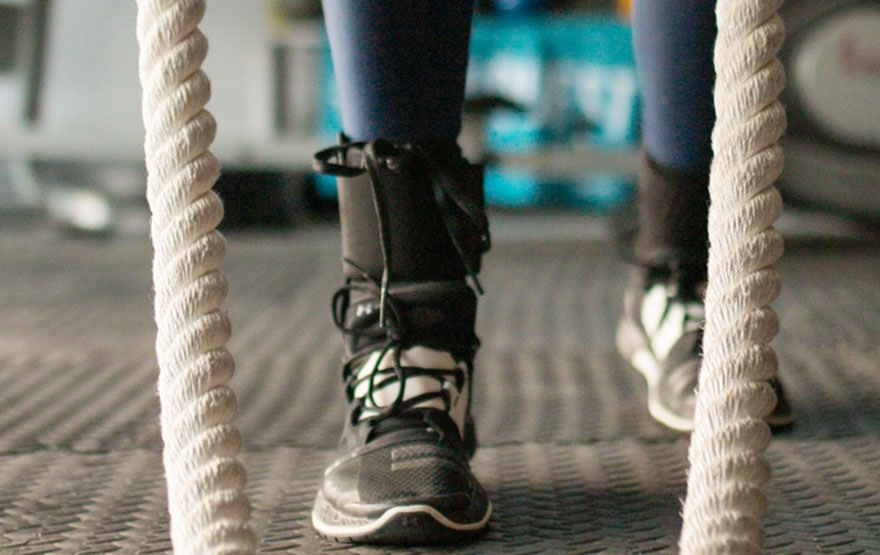Your Cart is Empty
Injury

When dealing with an acute Achilles tendon injury or moderate to severe pain, there are certain movements that can aggravate it. Knowing what Achilles tendonitis exercises to avoid is an important part of building a safe and effective exercise program. Keep scrolling to learn which exercises you should NOT do.
The calf muscles (and attached Achilles tendons) are specifically made to point the toes and lift the heels off the ground. This provides the power you need for pushing off movements like walking, running, and jumping. Minimizing these moves can help relieve pain.
Safe Exercises for Achilles Tendonitis
Running requires a lot of ankle stability and strength. Each time you push forward your calf muscles are working hard. Taking a complete rest from running may be necessary with more severe symptoms. Otherwise, modification is possible without completely stopping. Try shortening your run distance, decreasing your cadence and avoiding running on hills. You may also want to try shoe insoles or orthotics for greater support.
Too much stretching can actually cause aggravation. This is particularly true if you have ankle instability or you are very flexible to begin with. If you are having issues with joint hypermobility, some stretches specific for the calf muscles may be enough. Whereas, if you tend to be stiff you can stretch 10-25 minutes as needed each day. Listen to your body to avoid overstretching.
Try these calf stretches that are safe for an injured Achilles tendon.
Jump training and high intensity moves put a lot of strain on the ankle, particularly the calves and Achilles tendon. It’s best to avoid them until you get your pain under control. Then, you can gradually build back into them. After an ankle injury, it’s best to start with coordination and proprioceptive exercises before getting back to full jumping.
If you participate in sports, you will need to modify your activities for a while to get your symptoms under control. Any activity that requires running or jumping may require a rest break from 1-6 weeks depending on the severity of the injury. Sports to avoid or take a short rest break from include baseball, gymnastics, soccer, softball, basketball, and tennis.
With Achilles tendinitis, it’s also important to pay attention to some daily activities that might be aggravating your pain without even knowing it. Try to avoid these certain movements as much as possible to allow healing and prevent a progression to Achilles tendinopathy. If that’s not possible, get the most support and protection possible. Consider orthotics, bracing or utilizing Achilles tendon taping.
Any move that involves climbing or an upward incline requires extra strength and power from the calf muscles (gastrocnemius and soleus). This puts extra tension and strain on the Achilles tendon each time you take a step forward. If you plan to walk, choose a flat route without hills. If you have stairs at home, limit the number of times you need to use them and use an elevator when in buildings. You can also modify the way you’re walking up your stairs by using other muscles in your lower leg like the hips and knees more than your ankle.
Any activity that requires lifting your heels up off the floor directly stresses the Achilles tendon as the calf muscles are activated. Thus, this is one of the most aggravating moves you can do, especially when your heel drops back to the ground after lifting it up. Avoid walking on your toes, standing on your toes to reach anything, or wearing high heeled shoes when you can. Do your best to keep your heel bone on the ground.
When it comes to Achilles tendon recovery, the biggest factor is allowing enough rest before getting back to your normal activities (gradually). Keep these tips in mind to maximize your results:
Do These Stretches Before Exercising
When you ignore painful symptoms it can lead to further damage and aggravation, and in this case can even cause an Achilles tendon rupture. Achilles tendonitis is most often caused by overuse- thus recovery will require a reduction in intensity and activity.
Achilles Tendon Injury Overview
Exercising your lower leg after an ankle injury requires a delicate balance of rest and movement. When you tune into your symptoms, you can use them as a guide to decide what’s right for you. If your symptoms aren’t getting better within a few weeks or get worse, make sure to get in touch with your orthopedic doctor or physical therapist for medical advice.
Sources:
https://footadvice.com/achilles-tendonitis-exercises-to-avoid-doing/
https://www.drpribut.com/sports/spachil.html
Achilles Tendonitis Products
![The Benefits of Flexibility [A.K.A. The Secret Sauce for Aging]](http://www.vivehealth.com/cdn/shop/articles/Smiling-retired-woman-listening-to-music-while-stretching-legs-outdoors._600x.jpg?v=1713090677)

